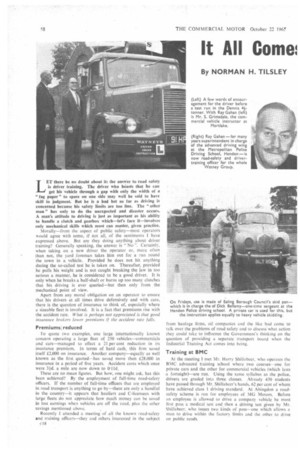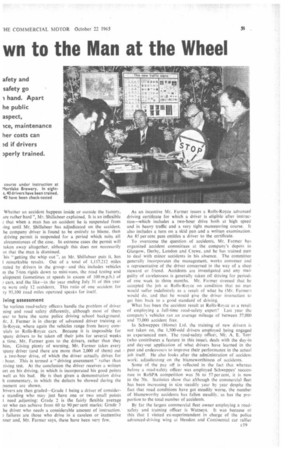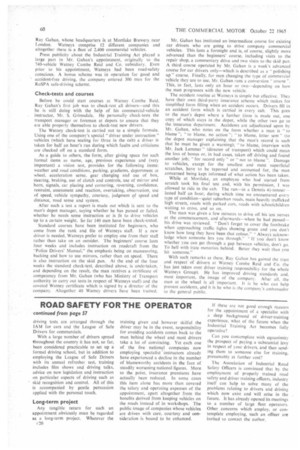It All Come wn to the Man at the Wheel
Page 60

Page 61

Page 62

If you've noticed an error in this article please click here to report it so we can fix it.
By NORMAN H. T1LSLEY
LET there be no doubt about it: the answer to road safety is driver training. The driver who btiasts that he can get his vehicle through a gap with only the width of a " fag paper" to spare on one side may well be said to have skill in judgment. But he is a bad bet so far as driving is concerned because his safety limits are too fine. The '' other man" has only to do the unexpected and disaster occurs. A man's attitude to driving is just as important as his ability to handle a clutch and gearbox which—let's face it—involves only mechanical skills which most can master, given practice.
Morally—from the aspect of public safety—most operators would agree with some, if not all, of the sentiments I have expressed above. But are they doing anything about driver training? Generally speaking, the answer is " No". Certainly, when taking on a new driver the operator or, more often , than not, the yard foreman takes him out for a run round the town in a vehicle, Provided he does not hit anything during the so-called test he is taken on. Thereafter, provided he pulls his weight and is not caught breaking the law in too serious a manner, he is considered to be a good driver. It is only when he breaks a half-shaft or burns up too many clutches that his driving is ever queried—but then only from the mechanical point of view.
Apart from any moral obligation on an operator to ensure that his drivers at all times drive defensively and with care, there is the question of insurance to think of, especially where a sizeable fleet is involved. It is a fact that premiums rise with the accident rate. What is perhaps not appreciated is that good insurance broAers lower premiums if the accident rate falls.
Premiums; reduced To quote two examples, one large internationally known concern operating a large fleet of 250 vehicles—commercials and cars—managed to effect a 21 per cent reduction in its insurance premium. In terms of hard cash, this firm saved itself £2,000 on insurance. Another company—equally as well known as the first quoted—has saved more than £28,000 in insurance in a period of five years. Accident costs which once were 3,;(1. a mile are now down to 0.11d.
These are no mean figures. But how, one might ask, has this been achieved? By the employment of full-time road-safety officers. If the number of full-time officers that are employed in road transport is anything to go by—there are only a handful in the country—it appears that hauliers and C-licensees with large fleets do not appreciate how much money can he saved in lost earnings when vehicles are off the road, plus the other
savings mentioned above. , Recently I attended a meeting of all the known road-safety and training officers—they and others interested in the subject c18 from haulage firms, oil companies and the like had come to talk over the problems of road safety and to discuss what action they could take to influence the Government's thinking on the question of providing a separate transport board when the Industrial Training Act comes into being,
Training at BMC
At the meeting I met Mr. Harry Shillabeer, who operates the BMC advanced training school where two courses—one for private cars and the other for commercial vehicles (which lasts
fortnight)—are run. Using the same syllabus as the police, drivers are graded into three classes. Already 430 students have passed through Mr. Shillabeer's hands, 62 per cent of whom have achieved class 1 driving standard. At Abingdon a roadsafety scheme is run for employees of MG Motors. Before an employee is allowed to drive a company vehicle he must first pass a medical test and then a driving test given by Mr. Shillabeer, who issues two kinds of pass—one which allows a man to drive within the factory limits and the other, to drive on public roads.
Whether an accident happens inside or outside the factory, are rather hard", Mr. Shillabeer explained. It is an inflexible .) that when a man has an accident he is suspended from ring until Mr. Shillabeer has adjudicated on the accident. he company driver is found to be entirely to blame, then driving permit is suspended for a period which suits all circumstances of the case. In extreme cases the permit will taken away altogether, although this does not necessarily in that the man is dismissed.
his "getting the whip out ", as Mr. Shillabeer puts it. has I remarkable results. Out of a total of 1,117.212 miles :rated by drivers in the group—and this includes vehicles in the 7-ion rigids down to mini-vans, the road testing and elopment (sometimes at speeds in excess of 100 m.p.h.) of 7 cars, and the like—in the year ending July 31 of this year re were only 12 accidents, This ratio of one accident for ry 93,100 road miles operated speaks for itself.
iving assessment
'he various road-safety officers handle the problem of driver fling and road safety differently, although most of them ear to have the same police driving school background. 4r. J. Farmer is in charge of advanced driver training at Is-Royce, where again the vehicles range from heavy corn-cials to Rolls-Royce cars. Because it is impossible for ipany drivers to he taken off their jobs for several weeks a time, Mr. Farmer goes to the drivers, rather than they him. Giving plenty of warning, Mr. Farmer takes every ipany driver (and there are more than 2,000 of them) out a two-hour drive, of which the driver actually drives for hour. This is termed a--" driving assessment rather than riving test. At the conclusion the driver receives a written ort on his driving, in which is incorporated his good points well as his bad. He is then given a demonstration drive h commentary, in which the defects he showed during the :ssment are shown.
Myers are then graded—Grade 1 being a driver of considere standing who may just have one or two small points t need Adjusting: Grade 2 is the fairly flexible average ler who can achieve from 60 to 90 per cent marks: Grade 3 he driver who needs a considerable amount of instruction, failures are those who drive in a careless or inattentive [-trier and, Mr. Farmer says, these have been very few. As an incentive Mr. Farmer issues a Rolls-Royce advanced driving certificate for which a driver is eligible after instruction—which includes a two-hour drive both at high speed and in heavy traffic and a very tight manceuvring course. It also includes a turn on a skid pan and a written examination. An 85 per cent pass entitles a driver to the certificate.
To overcome the question of accidents, Mr. Farmer has organized accident committees at the company's depots in Glasgow. Derby, London and Crewe, and he has trained men to deal with minor accidents in his absence. The committee generally incorporates the management. works convener and a representative of the driver concerned in the way of a shop steward or friend. Accidents are investigated and any man guilty of carelessness is generally taken off driving for periods of one week to three months. Mr. Farmer stressed that he accepted the job at Rolls-Royce on condition that no man would suffer indefinitely as a result of what he (Mr. Farmed would do, and that he would give the driver instruction to get him back to a good standard of driving.
What has been the accident result at Rolls-Royce as a result of employing a full-time road-safety expert? Last year the company's vehicles ran an average mileage of between 57,000 and 73,000 accident free.
In Schweppes (Home) Ltd. the training of new drivers is not taken on, the 1,500-odd drivers employed heing engaged as experienced men. The road-safety officer. Mr. A. E. -leer (who contributes a feature in this issue), deals with the day-in and day-out application of what drivers have learned in the past and endeavours to improve their performance in the actual job .itself. He also looks after the administration of accident work'. adjudicating on the blameworthiness of accidents.
Some of the pay off is reflected in the fact that whereas before a road-safety officer was employed Schweppes' success rate in RoSPA competition was 56 to 57 per cent. it is now in the 70s. Statistics show that although the commercial fleet has been increasing in size steadily year by year despite the fact that road conditions have got steadily worse, the number of blameworthy accidents has fallen steadily, as has the proportion to the total number of accidents.
By far the largest commercial fleet owner employing a roadsafety and training officer is Watnevs. It was because ot this that I visited ex-superintendent in charge of the police advanced-driving wing at Hendon and Continental car rather
Ray Gahan, whose headquarters is at Mortlake Brewery, near London. Watneys comprise 12 different companies and altogether there is a fleet of 2,400 commercial vehicles.
Press publicity about the Industrial Training Act played a large part in Mr. Gahan's appointment, originally to the 740-vehicle Watney Combe Reid and Co. subsidiary. Even prior to his appointment, Watneys had been road-safety conscious. A bonus scheme was in operation for good and accident-free driving, the company entered 300 men for the RoSPA safe-driving scheme.
Check-tests and courses
Before he could start courses at Watney Combe 'Reid, Ray Gahan's first job was to check-test all drivers—and this he is still doing with the help of his commercial-vehicle instructor, Mr. S. Grimsdale. He personally check-tests the transport manager or foreman at depots to ensure that they are able properly themselves to check-test new drivers.
The Watney check-test is carried out to a simple formula. Using one of the company's special "driver under instruction" vehicles (which have seating for three in the cab) a driver is taken for half an hour's run during which faults and criticisms are checked off on a standard form.
As a guide to others, the form, after giving space for such formal items as name, age, previous experience and (very important) a vision test, provides for the following items: weather and road conditions, parking, gradients, deportment at wheel, acceleration sense, gear changing and use of box, steering, braking, use of clutch and controls, use of mirror and horn, signals, car placing and cornering, reversing, confidence, restraint, assessment and reaction, overtaking, observation, use of speed, vehicle sympathy, courtesy, judgment 0 speed and distance, road sense and system.
After such a test a report is made out which is sent to the man's depot manager, saying whether he has passed or failed, whether he needs some instruction or is fit to drive vehicles up to a certain weight. So far 140 men have been check-tested.
Standard courses have been instituted for beginners, who come from the rank and file of Watneys staff. If a new driver is needed, Watneys prefer to employ one from their staff rather than take on an outsider. The beginners' course lasts four weeks and includes instruction on roadcraft from the 'Police Drivers' Manual," the emphasis being on mantruvring, backing and how to use mirrors, rather than on speed. There is also instruction on the skid pan. At the end of the four weeks the standard check-test, described above, is undertaken, and depending on the result, the man receives a certificate of competency from Mr. Gahan (who has Ministry of Transport authority to carry out tests in respect of Watneys staff) and the coveted Watney certificate which is signed by a director of the company. Altogether 40 Watney drivers have been trained.
Mr. Gahan has instituted an intermediate course for existing car drivers who are going to drive company commercial vehicles. This lasts a fortnight and is, of course, slightly more advanced than the beginners' course, including visits to the repair shop, a commentary drive and two visits to the skid pan. A third course operated by Mr. Gahan is a week's advanced course for car drivers only—which is described as a " polishing up" course. Finally, for men changing the type of commercial vehicle they are to use. Mr. Gahan runs a conversion " course ' This, in fact, lasts only an hour or two—depending on how the man progresses with the new vehicle.
The accident routine at Watneys is simple but effective. They have their own third-party insurance scheme which makes for simplified form filling when an accident occurs. Drivers fill in an accident form which is carried in every cab. This goes to the man's depot where a further form is made out, one copy of which stays in the depot, while the other two go to the insurance department. Accidents are adjudicated upon by Mr. Gahan, who notes on the form whether a man is "to blame"; " to blame, no action "; " to blame, letter sent" (to the depot manager explaining that the man's record is such that he must be given a warning); "to blame, interview with Mr. Jack Lemmer (director of transport) which could mean the loss of bonus or, in bad cases, taken off driving and found another job; "for record only" or " not to blame ". Damage to vehicles, except for the smallest and most superficial scratches, have to be reported and accounted for, the man concerned being kept informed of what action has been taken.
While at Mortlake, an employee who had started from scratch took his final test and, with his permission, I was allowed to ride in the cab. The run—in a Dennis 4+-tormer lasted half an hour, during which time we encountered every type of condition—quiet suburban roads, main heavily trafficked high streets, roads with parked cars, roads with schoolchildren waiting to cross, and so on.
The man was given a few minutes to drive off his test nerves at the commencement, and afterwards—when he had passed— his drive was reviewed. " Don't forget to cover the footbrake when approaching traffic lights showing green and you don't know how long they have been that colour:' " Always acknow ledge when someone leis you through." If you'don't know whether you can get through a gap between vehicles, don't go. To hell with irate motorists behind. Better they wait than you hit someone."
With such remarks as these. Ray Gahan has gained the trust and respect of drivers at Watney Combe Reid and Co. (he has just taken over driver training responsibility for the whole Watneys Group). He has improved driving standards and, most important, the image of the company. After all, the man at the wheel is all important. It is he who can help prevent accidents, and it is he who is the company's ambassador to the general public.
















































































































